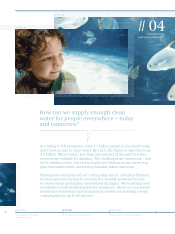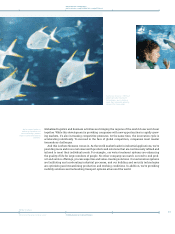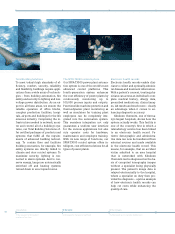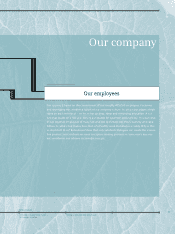Siemens 2009 Annual Report Download - page 31
Download and view the complete annual report
Please find page 31 of the 2009 Siemens annual report below. You can navigate through the pages in the report by either clicking on the pages listed below, or by using the keyword search tool below to find specific information within the annual report.-
 1
1 -
 2
2 -
 3
3 -
 4
4 -
 5
5 -
 6
6 -
 7
7 -
 8
8 -
 9
9 -
 10
10 -
 11
11 -
 12
12 -
 13
13 -
 14
14 -
 15
15 -
 16
16 -
 17
17 -
 18
18 -
 19
19 -
 20
20 -
 21
21 -
 22
22 -
 23
23 -
 24
24 -
 25
25 -
 26
26 -
 27
27 -
 28
28 -
 29
29 -
 30
30 -
 31
31 -
 32
32 -
 33
33 -
 34
34 -
 35
35 -
 36
36 -
 37
37 -
 38
38 -
 39
39 -
 40
40 -
 41
41 -
 42
42 -
 43
43 -
 44
44 -
 45
45 -
 46
46 -
 47
47 -
 48
48 -
 49
49 -
 50
50 -
 51
51 -
 52
52 -
 53
53 -
 54
54 -
 55
55 -
 56
56 -
 57
57 -
 58
58 -
 59
59 -
 60
60 -
 61
61 -
 62
62 -
 63
63 -
 64
64 -
 65
65 -
 66
66 -
 67
67 -
 68
68 -
 69
69 -
 70
70 -
 71
71 -
 72
72 -
 73
73 -
 74
74 -
 75
75 -
 76
76 -
 77
77 -
 78
78 -
 79
79 -
 80
80 -
 81
81 -
 82
82 -
 83
83 -
 84
84 -
 85
85 -
 86
86 -
 87
87 -
 88
88 -
 89
89 -
 90
90 -
 91
91 -
 92
92 -
 93
93 -
 94
94 -
 95
95 -
 96
96 -
 97
97 -
 98
98 -
 99
99 -
 100
100 -
 101
101 -
 102
102 -
 103
103 -
 104
104 -
 105
105 -
 106
106 -
 107
107 -
 108
108 -
 109
109 -
 110
110 -
 111
111 -
 112
112 -
 113
113 -
 114
114 -
 115
115 -
 116
116 -
 117
117 -
 118
118 -
 119
119 -
 120
120 -
 121
121 -
 122
122 -
 123
123 -
 124
124 -
 125
125 -
 126
126 -
 127
127 -
 128
128 -
 129
129 -
 130
130 -
 131
131 -
 132
132 -
 133
133 -
 134
134 -
 135
135 -
 136
136 -
 137
137 -
 138
138 -
 139
139 -
 140
140 -
 141
141 -
 142
142 -
 143
143 -
 144
144 -
 145
145 -
 146
146 -
 147
147 -
 148
148 -
 149
149 -
 150
150 -
 151
151 -
 152
152 -
 153
153 -
 154
154 -
 155
155 -
 156
156 -
 157
157 -
 158
158 -
 159
159 -
 160
160 -
 161
161 -
 162
162 -
 163
163 -
 164
164 -
 165
165 -
 166
166 -
 167
167 -
 168
168 -
 169
169 -
 170
170 -
 171
171 -
 172
172 -
 173
173 -
 174
174 -
 175
175 -
 176
176 -
 177
177 -
 178
178 -
 179
179 -
 180
180 -
 181
181 -
 182
182 -
 183
183 -
 184
184 -
 185
185 -
 186
186 -
 187
187 -
 188
188 -
 189
189 -
 190
190 -
 191
191 -
 192
192 -
 193
193 -
 194
194 -
 195
195 -
 196
196 -
 197
197 -
 198
198 -
 199
199 -
 200
200 -
 201
201 -
 202
202 -
 203
203 -
 204
204 -
 205
205 -
 206
206 -
 207
207 -
 208
208 -
 209
209 -
 210
210 -
 211
211 -
 212
212 -
 213
213 -
 214
214 -
 215
215 -
 216
216 -
 217
217 -
 218
218 -
 219
219 -
 220
220 -
 221
221 -
 222
222 -
 223
223 -
 224
224 -
 225
225 -
 226
226 -
 227
227 -
 228
228 -
 229
229 -
 230
230 -
 231
231 -
 232
232 -
 233
233 -
 234
234 -
 235
235 -
 236
236 -
 237
237 -
 238
238 -
 239
239 -
 240
240 -
 241
241 -
 242
242 -
 243
243 -
 244
244 -
 245
245 -
 246
246 -
 247
247 -
 248
248 -
 249
249 -
 250
250 -
 251
251 -
 252
252 -
 253
253 -
 254
254 -
 255
255 -
 256
256 -
 257
257 -
 258
258 -
 259
259 -
 260
260 -
 261
261 -
 262
262 -
 263
263 -
 264
264 -
 265
265 -
 266
266 -
 267
267 -
 268
268 -
 269
269 -
 270
270 -
 271
271 -
 272
272 -
 273
273 -
 274
274 -
 275
275 -
 276
276 -
 277
277 -
 278
278 -
 279
279 -
 280
280 -
 281
281 -
 282
282 -
 283
283 -
 284
284 -
 285
285 -
 286
286 -
 287
287 -
 288
288 -
 289
289 -
 290
290 -
 291
291 -
 292
292 -
 293
293 -
 294
294 -
 295
295 -
 296
296 -
 297
297 -
 298
298 -
 299
299 -
 300
300 -
 301
301 -
 302
302 -
 303
303 -
 304
304 -
 305
305 -
 306
306 -
 307
307 -
 308
308 -
 309
309 -
 310
310 -
 311
311 -
 312
312 -
 313
313 -
 314
314 -
 315
315 -
 316
316 -
 317
317 -
 318
318 -
 319
319 -
 320
320 -
 321
321 -
 322
322
 |
 |

www.siemens.com/answers
www.siemens.com/climatechange-energysupply
Smart grid technology
A smart grid is an intelligent network
for power transmission and distribution
that is based on bidirectional communi-
cation among all the players in the
electricity market. It encompasses the
entire energy conversion chain, from
power generation to end consumer.
Power utilities must achieve a balance
between electricity production and the
actual electricity consumption of
households and industry. This task is all
the more daunting because energy
from renewable sources is fed into the
grid at irregular intervals. That’s where
the smart grid comes in, creating an
overarching structure comprising large,
centralized suppliers, small, decen-
tralized suppliers who feed into the
network only intermittently, and con-
sumers. This integrated approach is
made possible by features such as the
grid’s expanded automation structure,
advanced sensors and decentralized
information and communications
structure. In addition to enhancing the
efficiency and reliability of the power
supply chain, smart grids enable con-
sumers to actively participate in the
energy market and thus contribute to
climate protection.
Green data centers
Computers, servers and data centers
devour enormous amounts of electric-
ity. In Germany alone, data centers
consume as much power as . million
households. That translates into near-
ly million tons of CO – and the figure
is rising. In response to these chal-
lenges, we’ve developed our integrat-
ed Transformational Data Center port-
folio to address all data center needs
– from planning and assembly to op-
eration and outsourcing.
By consolidating data centers and
introducing leading-edge virtualiza-
tion technologies, we’re pushing the
capacity utilization of the data centers
we operate to over percent while
cutting energy consumption more
than percent. We also offer energy
recovery concepts that include the use
of waste heat and groundwater-based
cooling.
Energy-saving motors
Electric motors are now an integral
part of daily life and industrial activity,
powering everything from escalators,
ventilators and trains to paper ma-
chines. At a medium-sized paper-mak-
ing
company, for example, more than
, motors operate around the
clock. And they consume a lot of elec-
tricity: electric drives and motors ac-
count for up to percent of the en-
ergy consumed in industrial plants.
We’re tackling this challenge with new
energy-saving motors that reduce
power losses by as much as percent
compared to conventional motors. By
using frequency converters on previ-
ously unregulated drives, energy con-
sumption can be cut by up to per-
cent. When energy-saving motors and
frequency converters from Siemens
were installed at an automotive paint
line, for instance, the amount of power
consumed by the pumps, ventilators
and logistics installations was slashed
by an impressive two-thirds.
// 03
Climate change
and energy supply
66 Our structure
Climate change and energy supply 30 Globalization and competitiveness
